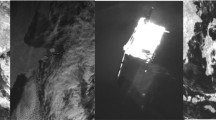Abstract
Space exploration has drawn increasing attention to space control technology. For debris removal missions and on-orbit servicing, accurate pose estimation of a noncooperative target is critical. This article introduces the satellite relative pose estimation network (SR-Net) two-stage training method for a noncooperative target via RGB images. As the first stage in regressing the 3D translation, we combined the detection and translation regression modules into a single model. SR-Net decouples the translation and rotation information in stage two by utilizing classification instead of regression, using the detected picture as input and fitting a rotation by minimizing the weighted least squares. Furthermore, a large-scale dataset for 6-DoF pose estimation is introduced, which can be utilized as a benchmark for various state-of-the-art monocular vision-based 6-DoF pose estimation methods. Ablation studies are used to verify the effectiveness and scalability of each module. SR-Net can be added to a baseline model as a separate module to improve the 6-DoF pose estimation accuracy for noncooperative targets. The results are extremely encouraging since they show that using only vision data, it is feasible to accurately estimate the 6-DoF pose of a noncooperative target.










Similar content being viewed by others
Data availability
The datasets generated and analyzed during the current study are available in the GitHub repository, https://github.com/walalala233/SR-Net.
References
Deng J, Dong W, Socher R, Li LJ, Li K, Li FF (2009) in: Imagenet: a large-scale hierarchical image database. In: IEEE conference on computer vision and pattern recognition, IEEE, CVPR 2009, 2009, pp. 248–255. https://doi.org/10.1109/CVPR.2009.5206848
Ding M, Wei L, Wang BF (2011) Vision-based estimation of relative pose in autonomous aerial refueling. Chin J Aeronaut 24:807–815. https://doi.org/10.1016/S1000-9361(11)60095-2
He KM, Zhang XY, Ren SQ, Sun J (2016) Deep residual learning for image recognition. In: Proceedings of the IEEE conference on computer vision and pattern recognition, CVPR 770–778. https://doi.org/10.1109/CVPR.2016.90
Kingma DP, Ba J (2014) Adam: A method for stochastic optimization. In: 3rd International Conference on LearningRepresentations, ICLR 2015 - Conference Track Proceedings. https://doi.org/10.48550/arXiv.1412.6980
Kisantal M, Sharma S, Park TH, Izzo D, Märtens M, D’Amico S (2020) Satellite pose estimation challenge: dataset, competition design, and results. IEEE T Aero Elec Sys 56:4083–4098. https://doi.org/10.1109/TAES.2020.2989063
Liao X, Wen QY, Zhang J (2013) Improving the adaptive steganographic methods based on modulus function. IEICE T Fund Electr 96:2731–2734. https://doi.org/10.1587/transfun.E96.A.2731
Liao X, Chen GY, Yin JJ (2016) Content-adaptive steganalysis for color images. Secur Commun Netw 9:5756–5763. https://doi.org/10.1002/sec.1734
Liao X, Peng J, Cao Y (2021) GIFMarking: the robust watermarking for animated GIF based deep learning. J Vis Commun Image R 79:103244. https://doi.org/10.1016/j.jvcir.2021.103244
Lin TY, Maire M, Belongie S, Hays J, Perona P, Ramanan D, Dollár P, Zitnick CL (2014) Microsoft coco: common objects in context. In: European conference on computer vision, Springer, ECCV 2014, 2014, pp. 740–755. https://doi.org/10.1007/978-3-319-10602-1_48
Liu Y, Xie ZW, Wang B, Liu H (2016) Pose measurement of a non-cooperative spacecraft based on circular features. In: IEEE international conference on real-time computing and robotics, RCAR 2016. IEEE 2016:221–226. https://doi.org/10.1109/RCAR.2016.7784029
Liu Y, Xie ZW, Liu H (2020) Three-line structured light vision system for non-cooperative satellites in proximity operations. Chin J Aeronaut 33:1494–1504. https://doi.org/10.1016/j.cja.2019.08.024
Markley FL, Cheng Y, Crassidis JL, Oshman Y (2007) Averaging quaternions. J Guid Control Dyn 30:1193–1197. https://doi.org/10.2514/1.28949
Park TH, Sharma S, D'Amico S (2019) Towards robust learning-based pose estimation of noncooperative spacecraft. In: AAS/AIAA Astrodynamics Specialist Conference, vol 171. p 3667–3686. https://doi.org/10.48550/arXiv.1909.00392
Paszke A, Gross S, Massa F et al (2019) Pytorch: an imperative style, high-performance deep learning library. Adv Neural Inf Proces Syst 32:8026–8037
Phisannupawong T, Kamsing P, Torteeka P, Channumsin S, Sawangwit U, Hematulin W, Jarawan T, Somjit T, Yooyen S, Delahaye D, Boonsrimuang P (2020) Vision-based spacecraft pose estimation via a deep convolutional neural network for noncooperative docking operations. Aerospace-Basel. 7(9):126. https://doi.org/10.3390/aerospace7090126
Proença PF, Gao Y (2020) Deep learning for spacecraft pose estimation from photorealistic rendering. In: IEEE International Conference on Robotics and Automation, ICRA 2020, 2020, pp. 6007–6013. https://doi.org/10.1109/ICRA40945.2020.9197244
Ren SQ, He KM, Girshick R, Sun J (2015) Faster r-cnn: towards real-time object detection with region proposal networks. Adv Neural Inf Proces Syst 28:91–99
Sharma S, D’Amico S (2020) Neural network-based pose estimation for noncooperative spacecraft rendezvous. IEEE T Aero Elec Sys 56:4638–4658. https://doi.org/10.1109/TAES.2020.2999148
Ventura J (2016) Autonomous proximity operations for noncooperative space targets. Dissertation, Technische Universität München
Wang G, Manhardt F, Tombari F, Ji XY (2021) GDR-net: geometry-guided direct regression network for monocular 6D object pose estimation. In: Proceedings of the IEEE/CVF Conference on Computer Vision and Pattern Recognition, CVPR 2021, 2021, pp. 16611–16621. https://doi.org/10.1109/CVPR46437.2021.01634
Xiang Y, Schmidt T, Narayanan V, Fox D (2018) PoseCNN: a convolutional neural network for 6D object pose estimation in cluttered scenes. In: Robotics: Science and Systems, RSS 2018. https://doi.org/10.15607/RSS.2018.XIV.019
Xu WF, Liang B, Li B, Xu YS (2011) A universal on-orbit servicing system used in the geostationary orbit. Adv Space Res 48:95–119. https://doi.org/10.1016/j.asr.2011.02.012
Yann LC, Yoshua B, Geoffrey H (2015) Deep learning. Nature 521:436–444. https://doi.org/10.1038/nature14539
Zhang HP, Jiang ZG (2014) Multi-view space object recognition and pose estimation based on kernel regression. Chin J Aeronaut 27:1233–1241. https://doi.org/10.1016/j.cja.2014.03.021
Author information
Authors and Affiliations
Corresponding author
Ethics declarations
Conflict of interest
Not applicable.
Additional information
Publisher’s note
Springer Nature remains neutral with regard to jurisdictional claims in published maps and institutional affiliations.
Rights and permissions
Springer Nature or its licensor (e.g. a society or other partner) holds exclusive rights to this article under a publishing agreement with the author(s) or other rightsholder(s); author self-archiving of the accepted manuscript version of this article is solely governed by the terms of such publishing agreement and applicable law.
About this article
Cite this article
Su, D., Zhang, C., Chen, Z. et al. SR-net: satellite relative pose estimation network for a noncooperative target via RGB images. Multimed Tools Appl 82, 31557–31573 (2023). https://doi.org/10.1007/s11042-023-14791-6
Received:
Revised:
Accepted:
Published:
Issue Date:
DOI: https://doi.org/10.1007/s11042-023-14791-6




